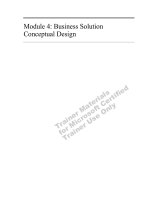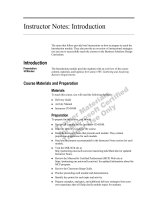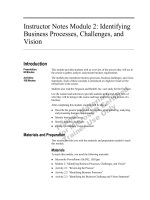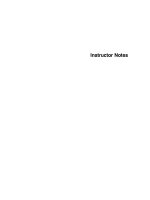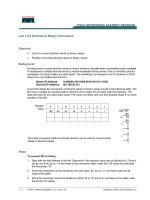Tài liệu Instructor Notes Module 5: Business - Solution Logical Design pptx
Bạn đang xem bản rút gọn của tài liệu. Xem và tải ngay bản đầy đủ của tài liệu tại đây (95.41 KB, 6 trang )
Instructor Notes Module 5: Business
Solution Logical Design
Introduction
In this module, students will learn about the basics of logical design, where it
fits in the Microsoft
®
Solutions Framework (MSF) Process Model, its purpose
and value in solution design, its steps and tasks, and its outputs and
deliverables. Students learn how the process of developing a logical design will
enable them to deliver solutions that match their customer’s requirements.
After completing this module, students will be able to:
!
Explain the need for a logical design in the process of designing a business
solution.
!
Describe the role of logical design in the MSF Design Process.
!
Describe the steps of logical design.
!
Identify the principles of modular design.
!
Assess the impact of implementation considerations on the logical design.
!
Design the objects and services of a business solution.
!
Derive a logical design for a business solution from a conceptual design.
Materials and Preparation
This section provides you with the materials and preparation needed to teach
this module.
Materials
To teach this module, you need the following materials:
!
Microsoft PowerPoint
®
file P05_1608a.ppt
!
Module 5, “Business Solution Logical Design”
!
Activity 5.1, “Risks of Skipping Logical Design”
!
Activity 5.2, “Identifying Business Objects and Services”
!
Activity 5.3, “Identifying Attributes and Relationships”
!
Activity 5.4, “Logical Design Verification”
Presentation:
120 Minutes
Activity:
140 Minutes
2 Instructor Notes Module 5: Business Solution Logical Design
Preparation
To prepare for this module, you should:
!
Read all the materials for this module.
!
Complete the activities.
Instructor Notes Module 5: Business Solution Logical Design 3
Activities
Activity 5.1: Risks of Skipping Logical Design
In this activity, students will participate in a class discussion to identify the
possible risks of not completing a logical design in the process of designing a
business solution.
After completing this activity, students will be able to:
!
Articulate the value of logical design and the risks of not completing a
logical design.
!
To prepare for the activity
1. Complete the activity yourself.
2. Prepare examples from your own experience.
3. Prepare some questions to foster a class discussion.
Activity 5.2: Identifying Business Objects and Services
In this activity, students will identify the business objects and services
contained in the scenario that the instructor provides.
First, they will analyze the usage scenario for potential business objects. These
candidate business objects are the logical constructs that help identify the
services, attributes, and relationships of the future solution.
Next they will analyze the usage scenario for potential services.
Finally, they will extend the analysis to identify hidden objects and services.
After completing this activity, students will be able to:
!
Analyze a usage scenario and determine candidate business objects and
services for use in the solution design.
!
To prepare for the activity
1. Prepare extra copies of the case study for students who may not have their
copy with them.
2. Prepare enough copies of the usage scenario for the class.
The class could use the consensus usage scenario from Module 4 or you can
supply the usage scenario from the suggested solutions.
3. Obtain flip charts, markers, and self-stick notes adequate for the number of
students in the class.
Note that these materials are also used in subsequent activities, so students
will need to adjust the amount needed upward to accommodate the
requirements of all the activities.
4. Complete the activity yourself.
Be sure to think of alternate answers that the student teams may perceive
and be prepared to discuss the merits of such alternative answers.
5. Review the suggested solution.
4 Instructor Notes Module 5: Business Solution Logical Design
6. Prepare examples from your own experience.
7. Prepare some questions to foster a class discussion.
Activity 5.3: Identifying Attributes and Relationships
In this activity, students will continue to analyze the selected future-state usage
scenario, focusing on the business object attributes and relationships.
First, they will identify the attributes of the business objects.
Next, they will identify the relationships between the business objects.
After completing this activity, students will be able to:
!
Analyze a usage scenario and determine candidate business object attributes
and relationships for use in the solution design.
!
To prepare for the activity
1. Complete the activity yourself.
2. Review the suggested solution.
3. Prepare examples from your own experience.
4. Prepare some questions to foster a class discussion.
Activity 5.4: Logical Design Verification
In this activity, students will participate in a class discussion to identify
methods of refining and verifying the logical design.
After completing this activity, students will be able to:
!
Articulate methods of validating a logical design.
!
To prepare for the activity
1. Complete the activity yourself.
2. Prepare examples from your own experience.
3. Prepare some questions to foster a class discussion.
Instructor Notes Module 5: Business Solution Logical Design 5
Module Strategy
Use the following strategy to present this module:
!
Logical Design Basics
This section provides an overview of the Logical Design Phase of the MSF
Process Model. Because many development organizations proceed directly
from research to physical design, the concept of an intermediate, logical
design may be difficult for some students to grasp. Some students may also
be unfamiliar with the concept of business objects. (Avoid any discussions
of Object Oriented Programming (OOP) objects. The discussion in this
course is about “business objects” and not objects in the OOP sense.)
Take your time laying the foundation in this section and be prepared with
some simple examples of logical design. Be sure to emphasize the risks of
skipping logical design, particularly in complex projects.
!
Activity 5.1: Risks of Skipping Logical Design
This discussion will enable you to gauge how well the students understood
the previous section. Use this opportunity to clarify any confusion that
might remain.
!
Logical Design Process
This section is a simple overview of the logical design process, including
the two steps of analysis and rationalization. Because the term “analysis”
was used in conceptual design, some students might be confused. If
necessary, take a moment to outline all the steps of the three phases of the
MSF Design Process so that students can grasp the flow and also see that
terms are used more than once.
!
Analysis: Business Objects and Services
A detailed discussion of business objects and services is in this section.
Take your time working through this section because many students may be
unfamiliar with the concepts. Have a number of examples prepared.
Be careful not to let the more experienced students try to move to physical
objects; emphasize that this is still logical design, and that they should not
yet be considering the development or implementation.
!
Activity 5.2: Identifying Business Objects and Services
This activity provides students with the opportunity to work in a team
environment on the logical design of the solution to the Ferguson and
Bardell, Inc. case study.
!
Analysis: Attributes and Relationships
This section completes the analysis step. By this time, students should be
beginning to understand the concept of business objects and their services,
attributes, and relationships. The “parts of speech” comparison
(objects=nouns, services=verbs, attributes=adjectives) may be helpful to
some.
Take a few moments at the end of the section to gauge the class’s grasp of
the concepts by presenting examples and having students analyze them.
Emphasize that the quality of the analysis done in this step will have a direct
impact on the quality of the physical design to follow.
6 Instructor Notes Module 5: Business Solution Logical Design
!
Activity 5.3: Identifying Attributes and Relationships
In this activity, students will identify the attributes and relationships of the
business objects from Activity 5.2.
!
Logical Design Rationalization
Some of the concepts in this section are more advanced than in the previous
sections. Issues of verification, coordination, and control may be difficult
for students to grasp. Be sure that you have a good understanding of the
concepts and try not to get bogged down in this section. The goal of the
previous sections was to provide students with the basic knowledge and
steps on which to build. This section builds upon that base knowledge by
introducing additional design concepts. You may be moving the students
outside of their comfort zone, so keep examples in mind to clarify these
concepts.
!
Activity 5.4: Logical Design Verification
This discussion will enable you to gauge students’ comprehension of the
final step of logical design, as well as their understanding of the Logical
Design Phase.
As with all discussions, it will be easier to foster a discussion if you have
questions prepared beforehand.
